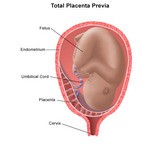 Are you nervous about having placenta previa?
Are you nervous about having placenta previa?
So am I.
During pregnancy, the placenta moves as the uterus stretches and grows. It is very normal for the placenta to be low in the uterus in early pregnancy. But as the pregnancy continues, the placenta typically moves to the top of the uterus. By the third trimester, the placenta should be near the top of the womb, so the cervix has a clear path for delivery. If the placenta attaches to the lower part of the uterus, it can cover part or all of the cervix (the entrance to the womb). When the placenta covers part or all of the cervix during the last months of pregnancy, this is a condition known as placenta previa, or low-lying placenta. This condition can cause severe bleeding before or during labor. Source
After some cramping-like contractions, my ultrasound showed that I have placenta previa, a serious complication of pregnancy.
I didn’t even know what questions to ask my doctor — until I found the following placenta previa resources online.
My Friend And I Both Have Placenta Previa
My doctor didn’t sound too worried. He said that in most cases, the placenta will migrate upward before the baby is born. If it doesn’t, a C-section is required.
We will have another ultrasound at 28 weeks to check.
Okay, okay, I’m telling myself. This isn’t too bad. I don’t want a C-section, but everything else looks normal…right?
Not really. I came home and immediately Googled placenta previa.
It’s a little more serious than I thought. Many women with complete previa are put on bed rest from 28 weeks until delivery. Bed rest! For the rest of the pregnancy! One weekend was nearly enough for me.
My friend Jerrie is struggling with the same worries.
Here’s how a mother of 12 is handling pregnancy with a complete placenta previa.
She convinced me I’d need to do my homework before my next appointment.
Here are some questions I’ll be asking my doctor, along with some potential answers I found online:
#1 – How likely is my placenta to move upward by delivery? When should the placenta have moved?
The good news: WebMD says that 90% of low-lying placentas detected at the 20-week ultrasound will move upward by delivery time.
The bad news: According to a support group, placenta previa at 34 weeks is not likely to resolve on its own. A C-section will be scheduled for as early as 37 weeks — as long as bleeding doesn’t occur before then.
#2 – Are there any warning signs I should be watching for?
Other than ultrasound, the main sign of placenta previa is painless bright red bleeding after the 2nd trimester.
#3 – Does placenta previa mean something is permanently wrong with my uterus?
The Mayo Clinic reports that placenta previa causes include scars in the endometrial lining, an extra-large placenta, or an abnormal shape.
#4 – What should I do if I’ve been diagnosed with placenta previa?
- Know what placenta previa means.
- Prepare yourself for the possibility of bed rest or premature birth.
- Adjust to the idea that a natural vaginal delivery might not be possible, for your own health.
- Watch for any signs of bleeding.



